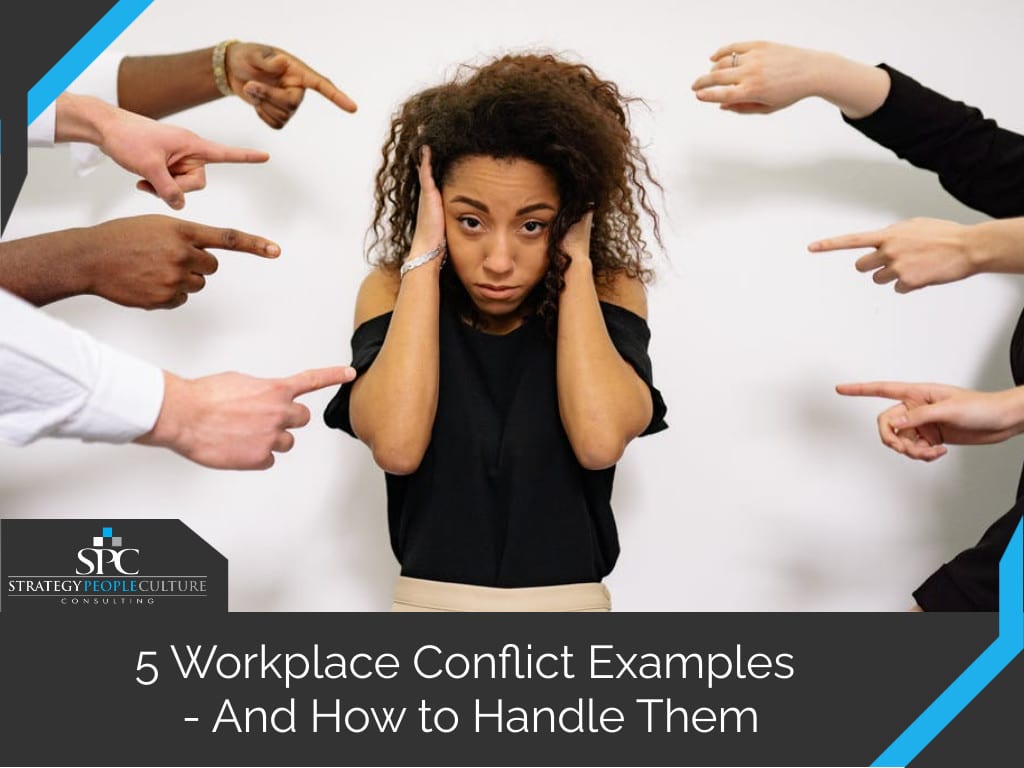5 Workplace Conflict Examples – And How to Handle Them

Conflict – it’s something every leader deals with, no matter their skill or experience level. There will always be complaints, disagreements, and problems that require your attention.
The key is learning how to handle these conflicts in a manner that contributes to a happier, more productive work environment.
As a leader, it’s up to you to anticipate, address, and solve problems through higher emotional intelligence and awareness. By learning to tackle conflicts appropriately, you can embrace the opportunity to create a positive company culture that benefits everyone.
Let us show you what we mean. Here are five sources of common workplace conflicts, as well as methods for handling the issues and preventing them from reoccurring.
1. An Employee Believes They Have Experienced Discrimination or Sexual Harassment
In 2020 alone, more than 67,000 discrimination charges were filed with the Equal Employment Opportunity Commission (EEOC).
While training and increased awareness may have contributed to fewer complaints than previous years, and discrimination seems to be dropping in many workplaces, that still reflects thousands of people who feel they have been discriminated against.
Typically, the plaintiffs report discrimination involving:
- Disability
- Race
- Sex
- Age
- National origin
- Color
- Religion
- Amongst other protected classifications
Discrimination complaints regarding any of the above factors (or others) should be addressed with the utmost respect and severity – for several reasons, to name a few:
First of all, taking it seriously shows you prioritize these issues. It sends a message to potential victims it is okay to raise even potentially emotional situations to management and to potential bad actors’ inappropriate behavior is not tolerated.
Secondly, making it clear a company culture in which discrimination is not tolerated will help everyone feel more comfortable, allowing them to be more productive. Additionally, appropriately handling discrimination complaints will help you lower the risk of legal action regarding discrimination suits.
How Do You Handle It?
As a leader, when someone comes to you with a discrimination or sexual harassment complaint, listen to their story with an open mind – regardless of prior complaints or other circumstances. Treat the employee with respect and compassion so they feel 100% comfortable sharing. Ask them for the complete story and note everything – including the dates, times, witnesses, situations, etc.
Once you’ve heard their complaint, there should be established company procedures which should include an objective investigation. Your first step is to reassure the victim(s) that you are taking adequate steps to handle and investigate the harassment. This will help the employee feel their concerns are taken seriously, as well as encourage other employees to be honest if they’ve experienced harassing behaviors.
If your company is facing problems with discrimination, you may want to look into professional employment discrimination training – both for leaders and for all employees. Real education on discriminatory behavior and procedures can seriously reduce the risk of complaints, as well as help your employees practice respect within their daily jobs.
2. One Employee Has Been Accused of Harassing or Discriminating Another
Another common workplace conflict situation is addressing the opposite part of a complaint, the person to who the complaint was made against. The EEOC defines harassment as:
“Unwelcome conduct that is based on race, color, religion, sex (including sexual orientation, gender identity, or pregnancy), national origin, older age (beginning at age 40), disability, or genetic information (including family medical history).
Harassment becomes unlawful where 1) enduring the offensive conduct becomes a condition of continued employment, or 2) the conduct is severe or pervasive enough to create a work environment that a reasonable person would consider intimidating, hostile, or abusive.”
Unfortunately, discrimination and harassment is a workplace conflict that is often difficult to pin down and is often underreported – especially when it comes to sexual misconduct. A 2019 study revealed that up to 38 percent of all women and 14 percent of men have reported sexual harassment at work.
Sexual harassment can involve unwelcome sexual advances, requests for sexual favors, verbal or non-verbal behaviors, inappropriate statements, lewd gestures, and explicit/inappropriate emails, texts, or images.
How Do You Handle It?
Whether you’ve heard rumors of sexual (or other) harassment at work, or someone has actually reported it to you, you must take action. Your leadership style – and attention to employee safety – sets the tone for the company.
If an employee is accused of sexual harassment, there are a few things to keep in mind.
For one, similar to the accuser, let the accused employee tell the whole story in his or her own words. Second, listen openly and write down all the relevant facts, including dates, times, witnesses, situations, and anything else that comes into play. Look for corroborating (or contradicting) instances, and of course, practice appropriate discretion.
Approach this process with an open mind and leave emotions out of it; just because an employee has been accused does not automatically mean they are guilty.
Third, make it clear any acts of retaliation will not be tolerated. Lastly, tell both the accuser and the accused to remain calm and patient while the investigation is conducted. Assure both parties that the investigation will be fair and objective.
If you haven’t already, ensure you understand what harassment and discrimination is and is not.
As with discrimination procedures, it’s a good idea to turn to harassment awareness and training – possibly from a third party. The National Conferences of State Legislatures (NCSL) encourages all employees (including managers and leaders) to undergo harassment training when starting a new job, with refresher training as often as once a year.
3. Poor Communication Resulted in a Mistake
Inadequate communication is one of the most common conflicts faced by business leaders. Whether it’s a set of instructions that were miscommunicated or a comment that was taken the wrong way, a communication conflict can quickly result in tension, poor productivity, and of course, errors.
This is an especially timely issue to consider – 42 percent of the labor force was working from home in the summer of 2020, and many are still working from remote locations. With people, more spread out and less face-to-face communication taking place, it’s essential that you address all communication problems head-on.
The worst thing a leader can do is leave a communication mistake unresolved. When something goes wrong, you must take a hard look at the situation to understand what happened, why it happened, and how you can prevent it from happening again.
How Do You Handle It?
Begin by addressing the situation immediately after it happens. Openly discuss the conflict with those involved – without fanning the flames or pointing fingers. Understanding yourself and your own style is important here. For example, if you tend to overreact, remember “immediately” could include taking an appropriate pause to avoid overreacting.
Once you’ve thoroughly explored what happened, set clear expectations for the future. What do you, as a leader, expect to see in terms of communication? How were these expectations not met, and how can employees realistically meet them going forward?
Remember to lead by example. If you want your employees to be strong listeners, demonstrate active listening. If you want them to be open and honest, reflect those values in your own communication style.
Does communication seem to be a recurring issue within your organization? You may want to consider some corporate leadership training that will help C-suite members and managers to set better examples for their staff.
4. Different Personalities or Work Styles Are Clashings
As a leader, you may also need to serve as a mediator between employees with different personalities, clashing preferences, or work style conflicts. Most research suggests different points of lead to better results; however, when people have different points of view, disagreements are pretty much inevitable – but that doesn’t mean they’re unsolvable.
Consider the four tendencies set by Gretchen Rubin, a writer who studies happiness. She explains that:
“In just about any role we play—as manager, health-care professional, team member, teacher, coach, spouse, parent, or colleague, to name a few—it’s helpful to know our own and other people’s Tendencies.
It’s hard to grasp just how differently we can all see the world. When we can see other people’s perspectives, we understand why, from their point of view, their actions make sense.”
Are you working with an employee who is a “questioner?” An “obliger”? Or perhaps a bit of a “rebel” who likes to do things their own way?
Of course, Rubin isn’t the only researcher to define different work styles/personalities. The point is that, as a leader, you will deal with conflicts that are rooted in employee differences – and that’s something you’ll need to address.
How Do You Handle It?
When it comes to handling workplace differences, your job as a leader is to encourage diversity while also finding ways for team members to successfully corroborate. One of the best ways to do this is to be self-aware, as well as conscious of those you work with.
What do you notice about each employee? Where are the sources of tension/difference, and how can you effectively address those sources?
If you feel a little out of your element studying personality types and work styles, consider looking into executive coaching that can help you learn more about how you can more effectively adapt to maximize the efforts of others. After all, it’s hard to play the role of company mediator and leader if you don’t feel comfortable learning about people and problem-solving for your team.
5. There’s Tension Between Departments
Lastly, let’s talk about the conflict of inter-departmental disagreements or tension. Departments might not get along if they don’t share goals or feel that they are unevenly supported by management.
Additionally, there’s a problem known as the “silo effect,” in which separate departments/teams within an organization don’t effectively communicate with each other. This can lead to poor collaboration, low productivity, and tension.
Roughly 75 percent of employees regard department collaboration and teamwork as important, and employees now spend an estimated 50 percent more time engaged in “collaborative” work. If you want to address conflict within the workplace, then you need to look at how your teams work together.
How Do You Handle It?
As Carol Kinsey Goman stated in her Forbes article, some of the best ways to encourage cooperation and success between departments are to:
- Reward collaboration between organizational boundaries
- Transparently communicate with every team
- Encourage company networking
- Create central goals that everyone can work toward
A big part of alleviating tension/disagreements between departments is centralizing the organization’s goals. To do that, leaders need to dedicate some serious time to understand the company’s objectives, learn how those objectives impact teams differently, and communicating expectations.
In Conclusion
Whether you’re dealing with discrimination, harassment, poor communication, or department tensions, learning conflict-resolution skills is an enormous aspect of successful leadership.
At Strategy People Culture, we offer executive and leadership coaching to help individuals with their problem-solving tactics. Additionally, we also offer workplace investigations and training services to discover the roots of common workplace conflicts – then work toward eliminating them.
If you want to improve your leadership qualities or schedule conflict resolution training for your employees, give us a call at 833 ROCK SPC (833-762-5772). You can also send us a message online.





